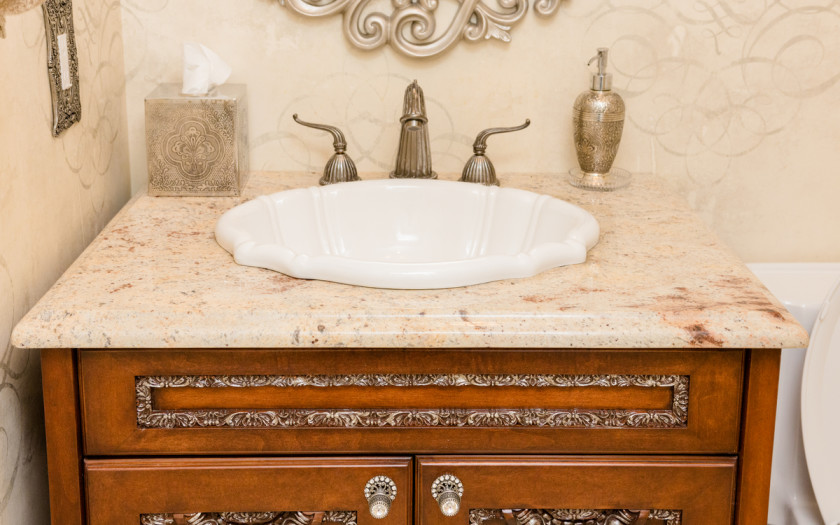When you’re looking to add natural stone to the bathroom, think beyond the tile! A stone vanity top is a great way to really enhance the elegance and beauty of the room, making it feel more like a luxury spa or a powder room than, well, just a bathroom. Just like with kitchen countertops, however, you need to make sure you find a stone that actually works for your needs and your lifestyle: if your vanity is a high-traffic area, better to choose something that’s more durable and low-maintenance than a piece that something that’s more of an elegant showpiece. So, what are your options? Let’s take a look!
Stone alone
First things first: what kind of punishment is your bathroom countertop going to take? If this is a room used by the whole famil, as opposed to a master bath or guest bathroom, you’re going to need to go with granite, soapstone, quartzite or quartz. All of these materials are phenomenally durable and resistant to water damage, which will be your primary concern. Although granite needs to be resealed periodically, it’s highly resistant to scratches, staining, humidity and running water, making it an ideal choice for the bathroom. Similarly, the resin used in man-made quartz make it impervious to water and moisture and it needs little to no maintenance, which is ideal in heavy traffic situations.
If the bathroom gets moderate to light usage, marble is an option to consider. As one of the most elegant and desirable stones, it instantly adds a luxurious, spa-like feel to the space. While marble can be tough to use as a kitchen countertop because of the acidic foods and liquids it is likely to encounter, this is less of a problem in the bathroom. And, while marble is more porous than other stones and can stain if water seeps into its pores, this also won’t be an issue if you stay on top of re-sealing it every 6 months to 1 year.
Softer stones like limestone and travertine are very absorbent and while they can be sealed to repel moisture, the frequent maintenance might become tiresome after a while.
Finish It Up
Once you know which stone you’d like to use for your vanity top, consider how it’ll be finished. Polished stones are elegant and striking, as you can practically see yourself in the mirror-like surface. However, a polished finish shows scratches more easily, which are more likely to occur in a high-traffic bathroom.
Honed stones have a matte finish and tend to show scratches less. However, it leaves the stone’s pores more open and vulnerable to water damage. Sealing can mitigate this, but there is an added risk of damage if you don’t stay on top of the maintenance. Plus, honed stones can show fingerprints and smudges more easily than other finishes. That being said, the satiny-smooth finish can look very elegant as a vanity top, but overall is an option best left to lower-traffic bathrooms.
A leathered finish is a good middle ground between the previous two options. It doesn’t show fingerprints, smudges, or scratches readily, and the finish tends to seal off pores rather than leave them exposed. A leathered stone still needs to be periodically re-sealed, but you won’t have to worry about it as much. However, the uneven surface may be difficult to deep-clean, as the stone surface will have lots of tiny pits and fissures.
Clean Smart
Although bathroom vanity tops usually don’t endure the same kinds of spills and messes that kitchen countertops do, you still have to be careful with how you clean it. Most bathroom cleaners tend to be very harsh and abrasive, which can easily damage a countertop by stripping the finish or causing stains. This goes for common bathroom cleaning tools as well: harsh scrub brushes and sponges may be fine for scouring the tub, but they’ll be much too strong for your natural stone vanity top. Instead, make sure you clean spills and excess water with a soft cloth or stone and a ph-neutral cleaner specially formulated for stone.
Finally, save yourself the heartache and don’t dye your hair over a natural stone sink, or even over stone tiles. Even if you’re being as careful as possible, it’s highly likely the pigmented dye will drip onto the stone and cause an immediate, very visible stain. This is one job you’ll want to leave to the porcelain sinks in your home: trust us, you and your stone will thank us!
Natural stone can be an ideal way to enhance the look of your bathroom. One glimpse of an elegant marble vanity top and you’ll understand why this material was used in the finest bath houses in the ancient world! Just remember to take stock of the traffic your bathroom get to help you zero in on a stone that will be as functional as it is beautiful. Got a question about which stone might be right for your powder room? Tell us it in the comments!


